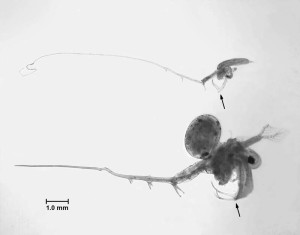
Non-native, invasive spiny waterflea has been found in Basswood Lake in the Boundary Waters Canoe Area Wilderness. The tiny crustaceans can disrupt the food chain by competing for food with—but not being eaten by—small native fish.
In high numbers, spiny waterflea interfere with and damage fishing gear and other water equipment. Anglers might hook a fish only to be unable to land it when the waterfleas clog the eyelets on a fishing pole. They were brought to American waters in the 1980s in the ballast water of ships from Europe and Asia.
The Star Tribune‘s Doug Smith reports that Basswood joins other northern Minnesota lakes in being infested, including “Crooked Lake, Iron Lake and Bottle Lake, which are downstream. The Basswood and Bottle rivers will also be designated as infested waters due to connectivity and the likelihood of infestation spread.”
According to the Minnesota Department of Natural Resources, the invasives are usually transported by anglers, “They can spread by attaching to fishing lines, downriggers, anchor ropes, and fishing nets. While female waterfleas die out of water, under certain conditions they produce eggs that resist drying and freezing, and can establish a new infestation. They also can be unintentionally transported in bilge water, bait buckets, or livewells.”
According to the Star Tribune, the latest discovery was confirmed by the University of St. Thomas and the DNR. DNR fisheries staff also found spiny waterflea in the stomachs of Basswood Lake cisco.

